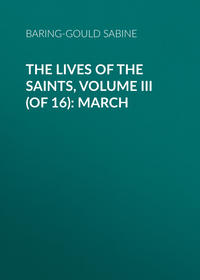 полная версия
полная версияThe Lives of the Saints, Volume 1 (of 16)
Every Saturday night, Genoveva was wont to watch in prayer, that the Lord coming in the Holy Eucharist of His day, might find his servant watching. It fell out that one stormy night, as the Sabbath drew towards Sunday morn, and the cock had crowed, she left her home to betake herself to the church of S. Denis, with the virgins who were her fellows, and the lantern that was carried before her was extinguished by a puff of wind; then the maidens were frightened at the pitch darkness, the howling of the storm, and the rain, and the road was so muddy that, without a light, they could not pick their way. Then Genoveva took the lantern in her hand, and the candle lighted of itself within; and holding it, she entered the church.
She performed several pilgrimages to the shrine of S. Martin, at Tours, in company with those holy women who lived with her, and imitated her virtues. She died at the age of eighty-nine, probably in the year 512; but the date is not to be ascertained with certainty.
Patroness of Paris.
Relics, in the church of S. Etienne du Mont, at Paris.
In art, S. Genoveva is represented, (1), with a devil blowing out her candle, and an angel rekindling it. Sometimes, in old sculpture, the devil is provided with a pair of bellows; or, (2), she is restoring sight to her mother with the water of the well of Nanterre; or, (3), guarding her father's sheep; or, (4), with the keys of Paris at her girdle, as patroness of the city; or, (5), holding bread in her lap; or, (6), with the well of Nanterre at her side.
S. BERTILIA, V(a. d. 687.)[Belgian and Gallo-Belgian Martyrologies. The life is from a MS. at Marolles, of uncertain date, but apparently authentic.]
Saint Bertilia was born of noble parents. From an early age her heart turned to the service of God alone, and she delighted in attending the offices of religion. A youth of noble blood, named Guthland, sought her hand in marriage, for she was very beautiful, gentle in speech, and modest in manner. But Bertilia refused him, desiring to retire into a solitary place; however, when her parents urged her vehemently, she gave a reluctant consent to their wishes, and was married. Nevertheless, at her desire, the young husband and she lived together in all chastity, as brother and sister, serving the poor, and given to hospitality. On the death of her husband, she divided his goods with the Church, and built a great church at Marolles, with a little cell adjoining it for her habitation. One night, after long protracted prayer in the church, she returned to her cell, where she was seized with excruciating pains; nevertheless, she knelt down and prayed with fervour, and prepared her soul for its departure. After having received the last Sacraments, she fell asleep in Christ, and was buried in the church she had built at Marolles. She was taken up and enshrined by Gerard II., Bishop of Cambray, on September 14th, 1081; and translated to another shrine on the 8th October, 1221.
Patroness of Marolles, in the diocese of Cambray.
Relics at Marolles.
January 4.
Octave of the Holy Innocents
S. Titus, B. and Ap. of Crete, circ. a.d. 105. SS. Aquilinus, Geminus, Eugenius, and Others, Martyrs in Africa. S. Dafrosa, W. C., at Rome, a.d. 361. S. Rumon, B. C., at Tavistock, in Devonshire. S. Gregory, B. of Langres, in France, circ. a.d. 541. S. Pharaildis, V., in Brabant, about a.d. 745. S. Rigobert, B. of Rheims, a.d. 749. S. Libentius, Abp. of Bremen, a.d. 1013. B. Angela, of Foligni, in Umbria, a.d. 1309.
S. TITUS, B(about 105.)[S. Titus is commemorated on this day in the Roman, and all the Latin Martyrologies. But the Greeks observe the feast of S. Titus on August 25th. Much of his history can be gathered from the first and second epistles of S. Paul to the Corinthians, and from his epistle to S. Titus; also from the Greek Menologium, and his life, written by Zenas, the lawyer, in the Menæa; and that by Peter de Natalibus, compiled from Greek sources.]
Saint Titus was born of Gentile parents, being descended from the ancient royal family of Crete.18 He was a favourite companion of S. Paul, who calls him his son in Christ. His virtue gained him the particular esteem of this Apostle; for we find him employed as secretary and interpreter by S. Paul; and the Apostle styles him his brother.19 On one occasion, when much depressed, he was consoled by the presence of Titus: "God, that comforteth those that are cast down, comforted us by the coming of Titus;"20 and he testified, on another occasion, that he found no rest in his spirit, because at Troas he had not met Titus.21
In the year 51, Titus accompanied S. Paul to the Council that was held at Jerusalem, on the subject of the Mosaic rites. Though the Apostle had consented to the circumcision of Timothy, in order to render his ministry more acceptable among the Jews, he would not allow the same in the case of Titus, apprehensive of giving thereby a sanction to the faction which held to the necessity of combining the rites of the Law with the Sacraments of the Gospel.
Towards the close of the year 56, S. Paul sent Titus from Ephesus to Corinth, with full commission to remedy several subjects of scandal, and to allay the dissensions in that Church. He was there received with great respect, and was satisfied with the penance and submission of the offenders; but could not be prevailed upon to accept from them any present, not even so much as his own maintenance. His love for that Church was very great, and at the request of the Corinthians, he interceded with S. Paul for the pardon of the incestuous man whom he had excommunicated. He was sent the same year by the Apostle, a second time, to Corinth, to bring the alms of that Church to Jerusalem, for the relief of the necessity of the poor Christians there. All these particulars we learn from S. Paul's two epistles to the Corinthians.
S. Paul, after his first imprisonment, returning from Rome into the East, made some stay in the island of Crete, of which Rustilius, the governor, was married to the sister of S. Titus. He consecrated his beloved disciple, Titus, to be bishop of that island, and left him there to finish the work he had begun.22 "We may form a judgment," says S. Chrysostom, "from the importance of the charge, how great was the esteem of S. Paul for his disciple."23 But the Apostle, on his return into Europe the year after, finding the loss of such a companion too material, ordered him to meet him at Nicopolis, in Epirus, where he intended to pass the winter, as soon as Artemas or Tychicus, whom the Apostle was about to send to him, to take the place of the bishop during his absence, should arrive.24 And when he came, he bade him assist Zenas, the lawyer, and Apollos on their journey.25 From this Zenas we have certain incidents of the life of S. Titus, which have been preserved in a fragmentary condition in the Greek Menæa.
Zenas relates the conversion of S. Titus thus: – Titus, living in the island of Crete, was learned in Greek literature, having been studious in youth. But the dreams of the poets and philosophers did not satisfy the inward craving of his soul after truth. One day, when twenty years old, he heard a voice say to him, "Titus, depart hence and save thy soul, for the learning of the Greeks will not profit thee unto salvation." Wondering in himself what this could mean, he was bidden by the same voice to take up a Hebrew volume that he had long disregarded, and open it. And the book was the Prophet Isaiah, and the place of the Scriptures that his eye rested on was this, "Keep silence before me, O islands; and let the people renew their strength: let them come near; then let them speak,"26 and what follows.
He seems to have read on much of that chapter, with its promise to the isles, and to have applied to himself the words, "Thou whom I have taken from the ends of the earth, and called thee from the chief men thereof, and said unto thee, Thou art my servant; I have chosen thee, and not cast thee away. Fear thou not; for I am with thee: be not dismayed; for I am thy God: I will strengthen thee; yea, I will help thee; yea, I will uphold thee with the right hand of my righteousness… When the poor and needy seek water, and there is none, and their tongue faileth for thirst, I the Lord will hear them, I the God of Israel will not forsake them."27 These were words very different from those of the poets of Greece, and gave an idea of God quite other from that formed by Homer, in whose writings he had found delight; so Titus left his Greek studies and his native island, and sought Jerusalem, the chief city of that people of whom the prophet spake such great things. And when he was there he saw Jesus, and heard Him teach. Perhaps he was one of those Greeks whom S. Andrew brought to Christ.28 He believed, and was of the number of the first disciples. He remained at Jerusalem after the ascension and the descent of the Holy Ghost. After he joined S. Paul, he accompanied him in most of his journeys. In 65, S. Paul sent him to preach the Word of God in Dalmatia, after he had visited him in Nicopolis;29 but he probably was there for no great length of time, though the Dalmatians honour him as their Apostle.
Peter de Natalibus relates that when death approached, he saw angels coming from heaven in a glorious train to fetch his soul, and that his face lit up with joy at their approach, and shone with supernatural splendour. He committed his people to God in long and earnest prayer, and then yielded up his spirit in peace to Christ his Saviour.
The body of S. Titus was kept, with great veneration, in the Cathedral of Gortyna; but that city having been ruined by the Saracens, in 823, the metropolitan see was transferred to Candia, seventeen miles from the ancient Gortyna; there the head of S. Titus was preserved, till it was carried off by the Venetians, and is now among the sacred treasures of S. Mark's, at Venice.
Patron of Candia, or Crete.
S. DAFROSA, W. C(a. d. 361.)[Mentioned in Roman Martyrology, and in those of Bede, Ado, Notker, Maurolycus, &c. All known of her is contained in the Martyrologies.]
This Saint was the wife of S. Flavian, a martyr. She was one of the few who suffered in the reign of Julian, the Apostate; having been sentenced by Apronianus, præfect of the city, in Rome, along with her daughters, Demetria and Bibiana. S. Flavian, her husband, was crowned on the 22nd December; and she followed him shortly. She was sent to the house of a certain Faustus, who desired to have her in marriage; but she refused to become his wife, and converted him to the faith. He was baptized by S. John the priest, who is commemorated on June 23rd. Faustus was executed, and his body cast to the dogs; but Dafrosa saved it, and buried it secretly at night. Then, in a dream, her husband Flavian appeared to her, and called her to follow him. And at the expiration of five days, whilst engaged in prayer, she migrated to her heavenly country.
S. RUMON, B. C[Does not occur in the Roman Martyrology.]
William of Malmesbury informs us that the history of S. Rumon's life was destroyed by the wars, which devastated England. He was a bishop; but of what see we do not know. Many of the early Saints of the Church in Cornwall, Wales, and Ireland, received episcopal consecration, without jurisdiction. His body was preserved at Tavistock, in Devonshire, where Ordulf, Earl of Devonshire, built a church under his invocation, before the year 960.
S. GREGORY OF LANGRES, B(about a.d. 541.)[Roman and Gallican Martyrologies. The life of S. Gregory of Langres was written by S. Gregory of Tours, who died 591.]
Saint Gregory, one of the principal senators of Autun, in France, was appointed count of the city, and for many years administered justice with the utmost prudence and uprightness. His wife, Armentaria, was also of senatorial rank; by her he had several children, of whom Tetricus was numbered among the Saints.
After the death of his wife, having been elected by the clergy and citizens of Langres to be their bishop, he was consecrated by the metropolitan. As bishop, his life was edifying. He was a model of humility, and sought, above all things, to conceal his acts of self-denial, and long communings with God. He ate barley bread, but that this might not be observed, he had wheat cakes piled on the table above his brown barley cakes, so that he could draw from the dish those for his own eating, whilst the others ate white bread, and supposed him to be doing the same. In like manner, at table he used a dull glass goblet, so that it might not be noticed that he drank water, whereas, the others were supplied with wine. At night, he was wont to rise from his bed, when everybody else was asleep, and steal, on tip-toe, to the baptistery of the church, where he passed several hours in prayer and singing psalms. This was long unobserved; but one night a deacon was awake, and saw the bishop rise. Wondering at his proceeding, when S. Gregory had left the dormitory, he rose also, and stole softly after him, and saw him enter the baptistery, the gate opening to him of its own accord. For some time there was silence; and then the bishop's voice was heard chanting, and immediately many voices took up the psalm, and the singing continued for three hours. "I, for my part," says S. Gregory, of Tours, "think that the Saints, of whom the relics were there preserved, revealed themselves to the blessed man, and sang praises to God in company with him."
One day, as he was walking to Langres, he was struck with fever, and he died shortly after; "and his blessed countenance was so glorified after his departure, that it looked like a blushing rose, whilst the rest of his body was shining like a white lily, so that it seemed then to have a foretaste of its future resurrection beauty." He was buried at Dijon, which was then in the diocese of Langres, and his son, Tetricus, succeeded him in the see of Langres.
There is much uncertainty about the date of his death. In some Martyrologies he is said to have died in 535; Galesinius says in 524. But he was present at the Council of Clermont, in 535, and signed the decrees of the third Council of Orleans by his deputy, Evantius, the priest, in 538; but did not appear at, or send a deputy to, the fourth Council of Orleans, in 541. It is, therefore, probable that the see was then vacant by his death.
In art, S. Gregory appears before a church door, which an angel opens to him; or with chains, because it is said that as his body was being taken to burial, the bier was set down before a prison, and the chains fell off the prisoners, and they were freed at the same moment.
S. PHARAILDIS, V(about a.d. 745.)[Belgian and German Martyrologies. Authorities for her life: – A MS. life from the monastery of Mont Gerard, published by the Bollandists, and by Molanus on the Belgian Saints. Besides, we have mention of her in the lives of her mother and sisters.]
Saint Pharaildis was the daughter of Theodoric, duke of Lorraine, and his wife, S. Amalberga. The family was one of Saints. The brother of S. Pharaildis, on the mother's side, was S. Emenbert, Bishop of Cambray, and her sisters were S. Rainelda and S. Gudula. She was born at Ghent, and after her baptism, was taken by her aunt, S. Gertrude, to be by her brought up. She was married, but lived with her husband as though single. For thirty years she rose every night at cock-crow, and sought the church of the nearest monastery to hear prime, and matins, and lauds. She died at the age of ninety, and was buried in the church of S. Bavo, in Ghent, a. d. 745, but afterwards was carried to Nivelles by the religious of Ghent, fleeing the incursions of the Normans. A portion of the relics was left at Nivelles, but the major part was brought back to Ghent, and enshrined in the new church of S. Pharaildis, which was destroyed by the Calvinists in 1566. The relics, however, were saved. On the 17th Dec., 1608, the chapter of S. Pharaildis, in Ghent, gave some portion to a little chapel at Steenockerzeel.
In Flemish, S. Pharaildis is called Veerle, or Verelde.
In art, S. Pharaildis appears as a patroness of Ghent, with a goose in her arms, or at her feet, Gans being the Flemish for a goose; in base Latin, Ganta or Gansa; and the Latin name of Ghent, in the Middle Ages, being Gantum. She is also represented with loaves of bread; for, according to a legend, a woman having begged bread of her sister for her child, the sister said, "I have none to give to you; there's no bread in the house." And when the poor woman urged her, she exclaimed, "May S. Pharaildis change the bread into stones if there be any here." Whereupon, some loaves she had by her were petrified.
S. RIGOBERT, ABP. OF RHEIMS(about a.d. 749.)[Roman, Benedictine, and Gallican Martyrologies. Authority: – A life of the 9th cent.]
Saint Rigobert, a Benedictine monk, was ordained archbishop of Rheims in the year 696. He consecrated Dagobert II., Chilperic II., and Theoderic II., kings of the Franks. In his diocese he laboured to restore discipline and sanctity of life. When Charles Martel and Ragenfried were fighting for the mastery, the former came with his troops before Rheims, and demanded to be admitted. The bishop refused to open the gates, "Because," said he, "I know not whether you or Ragenfried will be given the kingdom." Charles Martel went away in a fury, and vowed, if he gained the day, he would make the cautious archbishop suffer for it. When Charles Martel had subdued his rival, he returned to Rheims, and drove S. Rigobert into exile, and gave the revenues of the see to laymen, creatures of the court. Whilst at Rheims, S. Rigobert had lived over the city gate, and kept the keys of the town. The window of his chamber looked towards the Basilica of S. Remigius, and at it he was wont to pray, like Daniel, with his face turned to Jerusalem. That he might easily, and at will, descend into the church of S. Peter, which was situated near the gateway, S. Rigobert had a hole knocked in a turret of the church, so that by a ladder he could descend into the church to prayer, and return by it to a little oratory, dedicated to S. Michael, which he had built on the city wall. But this oratory did not stand very long, for King Louis gave the monastery of S. Peter to his daughter Alpaida; and her husband, Begus, having knocked his head against the lintel of the door when entering the little chapel – he being a very tall man – ordered it to be pulled down, pretending that it cut off the light from the windows of the church. "Humility," says the chronicler dryly, "never knocks its head against any thing."
S. Rigobert, when in exile, retired to Gascony, but was recalled by Pepin, and returned to Rheims; but finding that, contrary to canon law, Milo, an abbot, had been appointed to the see, he went away to Gernicour, a village at no great distance. At Gernicour, he lived in poverty, in great humility and prayer; sometimes he visited Rheims, that he might celebrate on the altar of S. Mary, which had been conceded to him by Milo. One day he was at Cormicy, and visited the church of S. Cyriac, to pray for his poor diocese, a prey to ravening wolves; and his prayer being ended, he conversed with Wibert, comptroller of Rheims, who invited him to dine with him, as the table was ready. But S. Rigobert answered, "I may not eat, as I have to celebrate mass this morning in the church of S. Peter, at Gernicour." Whilst he was speaking, a poor widow brought the deputy-governor a goose. "Here," said Wibert, "as you will not dine with me, take this goose home with you, and cook it for your own dinner." Then S. Rigobert gave it to his little serving boy to carry before him; and he went on his way saying his office; when the goose flew out of the boy's hands, and was gone. The boy was much grieved, and was on the point of crying. The bishop, seeing the sad face of the child, interrupted his psalm to console him, and to tell him that the loss of this world's goods should not draw forth tears, but that the heart should trust in God, who gives all things bountifully. Then the bishop resumed his psalms, now reciting them to himself, and then breaking forth into song. Presently the goose came fluttering down before the feet of the old man, so the boy put it under his arm again, and brought it safely to Gernicour. But it was not cooked for dinner. Indeed, the bishop would not allow it to be killed, and the goose became so tame, that it followed him about, and would even accompany him on his walks to Rheims, and wait there for him when he said mass at the altar of S. Mary.
Relics, in the church of S. Denis, at Rheims, and in the chapel of S. Rigobert, in the Cathedral of Notre Dame, at Paris.
In art, he is represented with a goose.
B. ANGELA. OF FOLIGNI(a. d. 1309.)[B. Angela was beatified by Pope Innocent XII. in 1693. Her life and revelations were written by her confessor, Arnald, friar of the order of S. Francis, in her lifetime, and the revelations were submitted to her for correction.]
The Blessed Angela, of Foligni, belonged to a rich and honourable family in Umbria. She was married, and had children. Upon the death of her mother, husband, and children, her heart turned in an agony of love to God alone, and appeared filled to overflowing with that divine charity of which an earthly affection is but a reflection. She was frequent in prayer, and made a discreet use of the Sacrament of penance. "Once she confessed her sins to me," says Friar Arnald, "preserving the most perfect knowledge of her sins, and was filled with so much contrition and tears, from the beginning of her confession to the end, and with so great humility, that I wept in my heart, believing most surely, that if the whole world was deceived, God would not permit her, who was full of so much truth and integrity, to be deceived. The following night she was sick, well nigh to death, and next morning she drew herself, with great effort, to the Franciscan Church, and I was then saying mass, and I communicated her, and I know that she never communicated without God giving her some great favour, and that a new one continually. But so great were the consolations and illuminations which she received in her soul, that frequently they seemed to overflow into her body. Thus, when she was standing with me, and her soul was lifted up, her face and body were transformed, through joy, at the divine words of address, and devotion, and delight at the consolations, that her eyes shone as candles, and her face flushed like a rose, and became radiant and angelical, as was beyond nature."
The inner life and meditations of the Blessed Angela were written down from her lips, and were read over to her by the confessor. They are full of instruction and beauty, and are of considerable length. She died on the 4th January, 1309.
Her body reposes in a shrine in the Franciscan Church at Foligni.
January 5.
The Vigil of the Epiphany
S. Telesphorus, P. M., a.d. 139. The Holy Martyrs in the Thebaid, a.d. 302. S. Syncletica, V., in Egypt, 4th cent. S. Apollinaris Syncletica, V., 5th cent. S. Simeon Stylites, H., a.d. 460. S. Emiliana, V., 6th cent. S. Edward the Confessor, K. of England, a.d. 1066. S. Gerlach, H., near Maestrecht, a.d. 1170.
S. TELESPHORUS, POPE, M(a. d. 139.)[Mentioned originally in the Carmelite Breviary. This Pope was inserted in the Roman Breviary by Clement VIII. He is commemorated by the Greeks on Feb. 22.]
Saint Telesphorus was by birth a Greek, and was the seventh Bishop of Rome. Towards the end of the year 128, he succeeded S. Sixtus I., and sat eleven years on the throne of S. Peter, and saw the havoc which the persecution of Hadrian wrought in the Church. "He ended his life by an illustrious martyrdom," says Eusebius.30
THE MARTYRS IN THE THEBAID(about a.d. 302.)"One cannot but admire," says Eusebius, in his Ecclesiastical History (lib. viii., c. 8, 9), "those who suffered in Egypt, their native land, where thousands, both men, and women, and children, despising the present life for the sake of our Saviour's doctrine, submitted to death in various shapes. Some, after being tortured with scrapings and the rack, and the most dreadful scourgings, and other innumerable agonies, which one might shudder to hear, were finally committed to the flames; some plunged and drowned in the sea, others voluntarily offering their heads to the executioners; others dying in the midst of their torments, some wasted away by famine, and others again fixed to the cross. Some, indeed, were executed as malefactors usually were; others, more cruelly, were nailed head downwards, and kept alive, until they were destroyed by starving, on the cross itself. But it would exceed all power of detail to give an idea of the sufferings and tortures which the martyrs of Thebais endured. These, instead of hooks, had their bodies scraped with potsherds, and were mangled in this way until they died. Women, tied by one foot, and then raised on high in the air by certain machines, with their naked bodies wholly uncovered, presented this most foul, cruel, and inhuman spectacle to all beholders; others again perished, bound to trees and branches. For, drawing the stoutest of the branches together by machines for this purpose, and binding the limbs of the martyrs to each of these, they then let loose the boughs to resume their natural position, designing thus to produce a violent action, to tear asunder the limbs of those whom they thus treated. But all these things were doing not only for a few days, or for some time, but for a series of whole years. At one time, ten or more; at another, more than twenty; at another time, not less than thirty, and even sixty; and again, at another time, a hundred men, with their wives and little children, were slain in one day, whilst they were condemned to various and varied punishments. We ourselves, when on the spot, saw many crowded together in one day, some suffering decapitation, some the torments of flames; so that the murderous weapon was completely blunted, and having lost its edge, broke to pieces; and the executioners themselves, wearied with slaughter, were obliged to relieve one another. Then, also, we were witnesses to the most admirable ardour of mind, and the truly divine energy and alacrity of those that believed in the Christ of God. For, as soon as the sentence was pronounced against the first, others rushed forward from other parts to the tribunal before the judge, confessing they were Christians, most indifferent to the dreadful and many kinds of tortures that awaited them, but declaring themselves fully, and in the most undaunted manner, on the religion which acknowledges only one Supreme God. They received, indeed, the final sentence of death with gladness and exultation, so far as even to sing and send up hymns of praise and thanksgiving, until they breathed their last."









